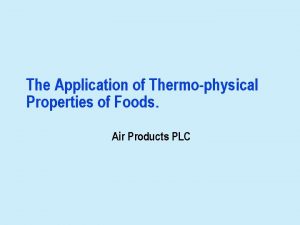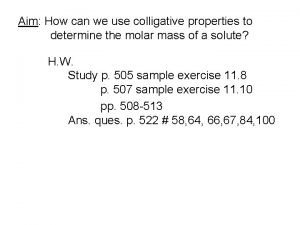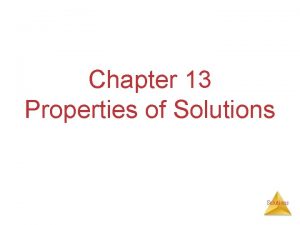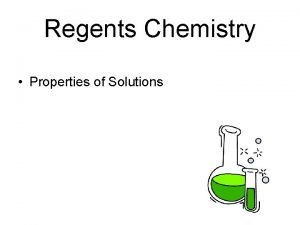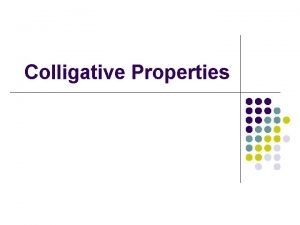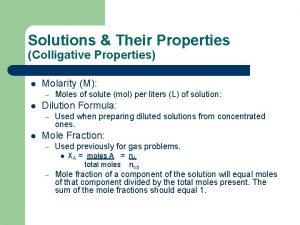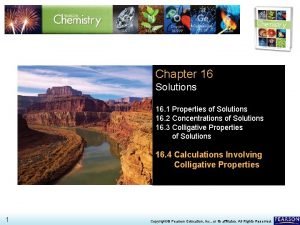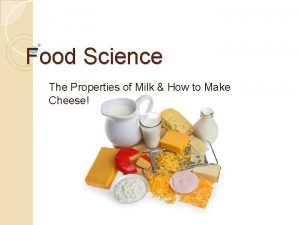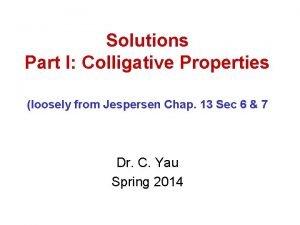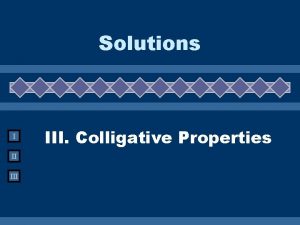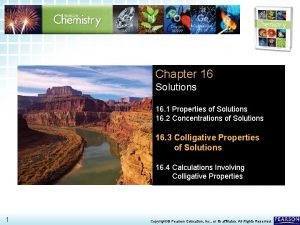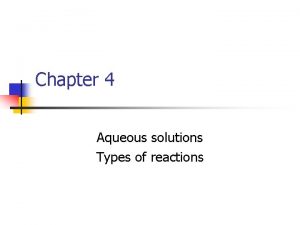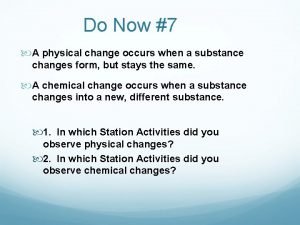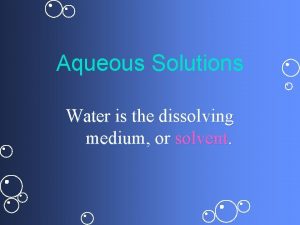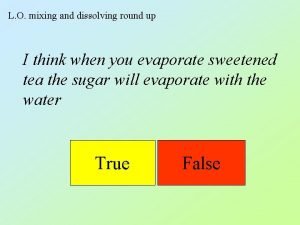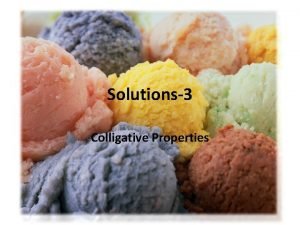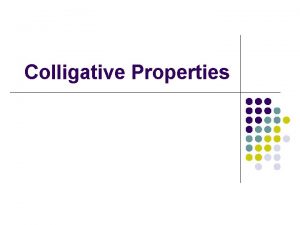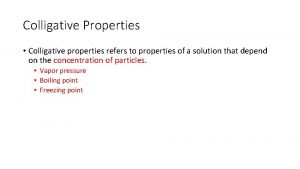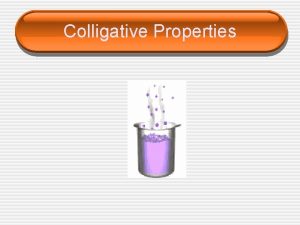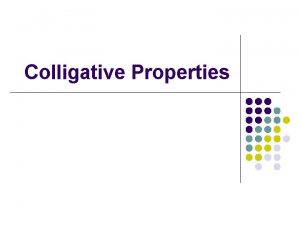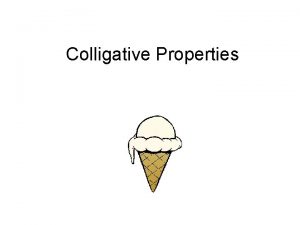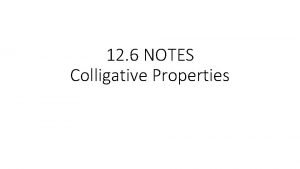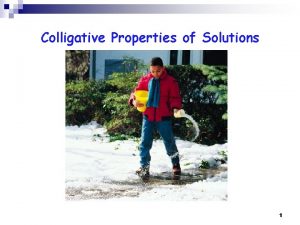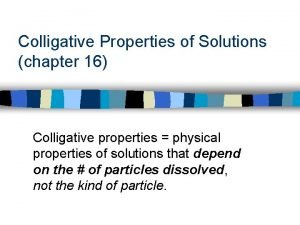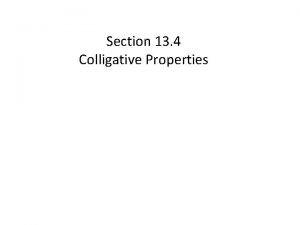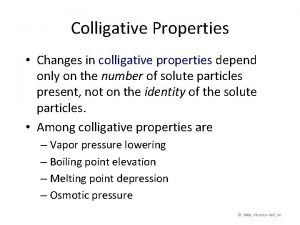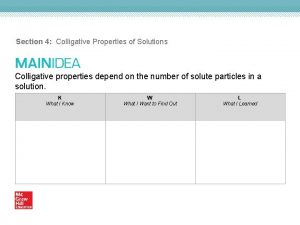13 5 Colligative properties v Dissolving solute in


























- Slides: 26

13. 5 Colligative properties v. Dissolving solute in pure liquid will change all physical properties of liquid, Density, Vapor Pressure, Boiling Point, Freezing Point, Osmotic Pressure v Colligative Properties are properties of a liquid that change when a solute is added. v The magnitude of the change depends on the number of solute particles in the solution, not on the identity of the solute particles.

Lowering the vapor pressure A liquid in a closed container will establish equilibrium with its vapor. When that equilibrium is reached, the pressure exerted by the vapor is called the vapor pressure The presence of a non-volatile solute means that fewer solvent particles are at the solution’s surface, so less solvent evaporates

Raoult’s Law Describes vapor pressure lowering mathematically v The lowering of the vapour pressure when a non. volatile solute is dissolved in a volatile solvent (A) can be described by Raoult’s Law: PA =XAP A only the solvent (A) contributes to the vapour pressure of the solution PA = vapour pressure of solvent A above the solution XA = mole fraction of the solvent A in the solution P A = vapour pressure of pure solvent A

Example: What is the vapor pressure of water above a sucrose (MW=342. 3 g/mol) solution prepared by dissolving 158. 0 g of sucrose in 641. 6 g of water at 25 ºC? The vapor pressure of pure water at 25 ºC is 23. 76 mm. Hg. Psoln =XH 2 O P H 2 O ( ( 1 mol C 12 H 22 O 11 g Moles C 12 H 22 O 11 =(158 = 0. 462 342. 3 g C 12 H 22 O 11) mol C 12 H 22 O 11 1 mol H 2 O ( 641. 6 g H O ) Moles H 2 O = 35. 6 2 18 g H 2 O = ( mol ( ( mol H 2 O mol H 2 O + C 12 H 22 O 11 ( XH O = 2 = mol 35. 6 = 0. 987 35. 6+ 0. 462 Psoln =(0. 987)(23. 76 mm. Hg) = 23. 5 mm. Hg

Example: Glycerin (C 3 H 8 O 3) is a nonvolatile nonelectrolyte with a density of 1. 26 g/m. L at 25 C of solution made by adding 50. 0 m. L of glycerin to 500. 0 m. L of water. The vapor pressure of pure water at 25 C is 23. 5 torrr and its density is 1. 0 g/m. L. Calculate the vapor pressure lowering PH O =XH 2 O P H 2 O 2 ( ( 1. 26 g C 3 H 8 O 3 1 mol C 3 H 8 O 3 m. L Moles C 3 H 8 O 3 = (50 = 0. 684 1 m. L C 3 H 8 O 3 92. 1 g C 3 H 8 O 3 C 3 H 8 O 3 ) mol = 1 mol H 2 O = 18 g H 2 O 27. 8 mol 27. 8 = 0. 976 27. 8+ 0. 684 PH O =(0. 976)(23. 8 torr) = 23. 2 torr 2 ( ( mol H 2 O + C 3 H 8 O 3 ( ( ( XH O = 2 1. 0 g H 2 O 1 m. L H 2 O ( Moles H 2 O = (500 m. L H 2 O)

Example: The vapor pressure of pure water at 110 C is 1070 torr. A solution of ethylene glycol and water has a vapor pressure of 1. 00 atm at 110 C. Assuming that Raoult’s law is obeyed, what is the mole fraction of ethylene glycol in the solution? PH O =XH 2 O P H 2 O = 1070 torr 2 P H 2 O = 1 atm = 760 torr P X H O = H 2 O = 760 2 P H O torr 1070 2 = 0. 710 torr C 2 H 6 O X H O + X 2 =1 2 X C H O = 1 0. 71 = 0. 290 2 6 2

Mixtures of Volatile Liquids Both liquids evaporate & contribute to the vapor pressure

Raoult’s Law: Mixing Two Volatile Liquids Since both liquids are volatile and contribute to the vapour, the total vapor pressure can be represented using Dalton’s Law: PT = P A + P B The vapor pressure from each component follows Raoult’s Law: PT = XAP A + XBP B Also, XA + XB = 1 (since there are 2 components)

Benzene and Toluene A two solvent (volatile) system v. The vapor pressure from each component follows Raoult's Law. v. Benzene - Toluene mixture: Recall that with only two components, XBz + XTol = 1 = 384 torr & Benzene: when XBz = 1, PBz = PBz when XBz = 0 , PBz = 0 Toluene: when XTol = 1, PTol = P Tol = 133 torr & when XTol = 0, PBz = 0

Example: A mixture of benzene (C 6 H 6) and toluene (C 7 H 8) containing 1. 0 mol of benzene and 2. 0 mol of toluene. What is the total vapor pressure of the solution? [vapor pressures of pure benzene and toluene are 75 torr and 22 torr, respectively] PT = XAP A + XBP B XC H = 1 = 6 6 1+2 0. 33 XC H = 2 = 7 8 1+2 PT = [(0. 33)(75 torr)] + [(0. 67)((22 torr)] = 24. 75 torr + 14. 75 torr = 39. 5 torr 0. 67

Boiling-point elevation and Freezing-point depression v In a solution of a nonvolatile solute, boiling and freezing points differ from those of the pure solvent Boiling point is elevated when solute inhibits solvent from escaping. v The boiling point of the solution is higher than that of the pure liquid Freezing point is depressed when solute inhibits solvent from crystallizing. v The freezing point of the solution is lower than that of the pure liquid

v The diagram below shows how a phase diagram is affected by dissolving a solute in a solvent. v The black curve represents the pure liquid and the blue curve represents the solution. v Notice the changes in the boiling & freezing points. Phase diagrams for a pure solvent and for a solution of nonvolatile

Boiling-point elevation v The increase of boiling point, Tb is directly proportional to the concentration of the solution expressed by its molality, m. Tb = (Tb –Tb ) = kbm Where, Tb = BP. Elevation Tb = BP of solvent in solution Tb° = BP of pure solvent m = molality , kb = BP Constant v The boiling-point elevation is proportional to the concentration of solute particles, regardless of whether the particles are molecules or ions v A 1 m aqueous solution of Na. Cl is 1 m Na+ and 1 m Cl-, making 2 m in total solute particles v The boiling-point of elevation of a 1 m aqueous solution of Na. Cl is (2 m)(0. 51 C/m) = 1 C.

Freezing-point depression v The decrease of freezing point, Tf is directly proportional to the concentration of the solution expressed by its molality, m. Tf = (Tf –Tf) = kfm Where, Tf = FP depression Tf = FP of solvent in solution Tf°= FP of pure solvent m = molality kf = FP depression constant

v The van 't Hoff factor, i : The van 't Hoff factor is the ratio between the actual concentration of particles produced when the substance is dissolved, and the concentration of a substance as calculated from its mass. v For most non-electrolytes dissolved in water, the van' t Hoff factor is essentially 1. v For most ionic compounds dissolved in water, the van't Hoff factor is equal to the number of discrete ions in a formula unit of the substance. Tf (measured) i= Tf (calculated for nonelectrolyte) For Na. Cl, van’t Hoff factor is 2, because Na. Cl consists of one Na+ and on Cl- per formula unit

Example: Automotive antifreeze consists of ethylene glycol, (CH 2(OH), a nonvolatile noneletrolyte. Calculate the boiling point and freezing point of a 25. 0 mass % solution of ethylene glycol in water. [kb=0. 51 ( C/m) and k. Let ( C/m). us consider we have 1000 g of solution: f=1. 86 Mass of ethylene glycol = 250 g Mass of water = 750 g ( ( ( m ( = (0. 51 C/m ) (5. 37 m) = 2. 7 Tb= Tb C +Tb = 2. 7 C +100 C = 102. 7 C ( Tb = (Tb –Tb ) = kbm ( ( ( Molality= moles C 2 H 6 O 2 = 250 g C 2 H 6 O 2 1 mol C 2 H 6 O 2 Kg H 2 O 750 g H 2 O 62. 1 g C 2 H 6 O 2 = 5. 37 1000 g 1 H 2 O kg H 2 O Tf = (T f –Tf ) = kfm = (1. 86 C/m ) (5. 37 m) = 10. 0 C Tf=T f – Tf = 0 C – 10 C = – 10. 0 C

Example: Calculate the freezing point of a solution containing 0. 600 kg of CHCl 3 and 42. 0 g of eucalyptol (C 10 H 18 O), a fragrant substance found in the leaves of eucalyptus trees [kf=4. 68 ( C/m) and Tf = 63. 5 C for chloroform]. ( ( ( 42 g C 10 H 18 O = 0. 60 kg CHCl 3 = 0. 45 m Tf = (T f –Tf ) = kfm = (4. 68 C/m ) (0. 45 m) = 2. 1 C Tf =T f – Tf = – 63. 5 C – 2. 1 C = – 65. 6 C ( ( ( Molality= moles C 10 CHCl H 18 O 3 Kg 1 mol C 10 H 18 O 154 g C 10 H 18 O

Example: List the following aqueous solutions in order of their expected freezing point : 0. 050 m Ca. Cl 2, 0. 15 m Na. Cl, 0. 10 m HCl, 0. 050 m CH 3 COOH, 0. 10 m C 12 H 22 O 11 Ca. Cl 2, Na. Cl and HCl are stronger electrolytes CH 3 COOH is week electrolyte C 12 H 22 O 11 is nonelectrolyte 0. 050 m Ca. Cl 2 0. 050 m in Ca 2+ and 0. 10 m in Cl- 0. 15 m in particles 0. 15 m Na. Cl 0. 15 m in Na+ and 0. 15 m in Cl- 0. 30 m in particles 0. 050 CH 3 COOH between m and 0. 10 mm. HCl 0. 10 m in H+ 0. 050 and 0. 10 m in 0. 10 Cl- m in 0. 20 m in particles 0. 050 m C H O 0. 10 m in particles 12 22 11 0. 15 m Na. Cl (lowest freezing-point ), 0. 10 m HCl , 0. 050 m Ca. Cl 2, 0. 050 m C 12 H 22 O 11, 0. 050 m CH 3 COOH (highest freezing-point )

Osmosis v Osmosis is the spontaneous movement of water across a semi-permeable membrane from an area of low solute concentration to an area of high solute concentration v Osmotic Pressure - The pressure that must be applied to stop osmosis

The osmotic pressure obeys a law similar in form to the ideal gas law V= n. RT =(n/V)RT = MRT , osmotic pressure of soln V, volume soln n, number of moles of solute R, ideal-gas constant M, molarity of soln v Two solutions having identical osmotic pressure are isotonic v Solution of lower osmotic pressure is hypotonic with respect to more concentrated soln v Solution of more concentrated solution is hypertonic with respect to the dilute soln

Example: The average osmotic pressure of blood is 7. 7 atm at 25 C. What molarity of glucose (C 6 H 12 O 6) will be isotonic with blood? = M RT M= RT T = 273 + 25 = 298 K R = 0. 0821 L. atm/mol. K = 7. 7 atm M=? 7. 7 atm M= (0. 0821 L. atm/mol. K)(298 K) = 0. 31 atm

Example: What is the osmotic pressure at 20 C of a 0. 0020 M sucrose (C 12 H 22 O 11) solution? = M RT T = 273 + 20 = 293 K R = 0. 0821 L. atm/mol. K M = 0. 0020 M = 0. 002 (mol/L) =? = (0. 0020 (mol/L)) (0. 0821 L. atm/mol. K)(293 K) = 0. 048 atm

v The colligative properties of solutions provides a useful means experimentally determining molar mass. Example: A solution of an unknown nonvolatile nonelectrolyte was prepared by dissolving 0. 25 g of the substance in 40. 0 g of CCl 4. The boiling point of the resultant solution was 0. 357 C higher than that of the pure solvent. Calculate the molar mass of the solute. Tb = kbm ( ( Tb 0. 357 C = = 0. 0711 m Molality = 5. 02 C/m Kb 0. 0711 mol solute Number of mole of solute in the solution = (0. 040 kg Kg CCl 4) = 0. 00284 mol solute = ( ( Molar mass = 0. 25 g 0. 00284 mol 88 g/mol

Example: Camphor (C 10 H 16 O) melts at 179. 8 C, and it has a particularly large freezing-point-depression constant, kf =40. 0 C/m. When 0. 186 g of an organic substance of unknown molar mass is dissolved In 22. 01 g of liquid camphor, the freezing point of the mixture is found to be 176. 7 C. What is the molar mass of the solute? Tf = 179. 8 – 176. 7 = 3. 1 C Tf = kfm Tf 3. 1 C = = 0. 0775 m Molality = Kf 40. 0 C/m = 0. 186 g 0. 0. 0017 mol 110 g/mol 0. 0775 mol solute kg Kg C 10 H 16 O (0. 02201 C 10 H 16 O) = 0. 0017 mol solute ( ( Molar mass = ( ( Number of mole of solute in the solution =

Example: The osmotic pressure of an aqueous solution of a certain protein was measured to determine the protein’s molar mass. The solution contained 3. 50 mg of protein dissolved in sufficient water to form 5. 00 m. L of solution. The osmotic pressure of the solution at 25 C was found to be 1. 54 torr. Treating the protein as a nonelectrolyte, calculate its molar T = 273 + 25 = 298 C mass. R = 0. 0821 L. atm/mol. K = 1. 54 torr =1. 54/760 = 0. 002026 atm = M RT Molarity 0. 002026 atm = (0. 0821 L. atm/mol. K )(298 K) = 8. 28 10 -5 mol /L Mole of solute in the solution = (5. 00 10 -3 L)(8. 28 10 -5 mol /L) = 4. 14 10 -7 mol ( ( Molar mass = 0. 0035 g 4. 14 10 -7 mol = 8. 45 103 g/mol

Example: A sample of 2. 05 g of polystyrene of uniform polymer chain length was dissolved in enough toluene to form 0. 100 L of solution. The osmotic pressure of this solution was found to be 1. 21 k. Pa at 25 C. Calculate the molar mass of the polystyrene. T = 273 + 25 = 298 C R = 8. 314 kg. m 2/S 2. mol. K = 1. 21 k. Pa=1210/101325 = 0. 01194 atm = M RT Molarity 0. 01194 atm = (0. 0821 L. atm/mol. K )(298 K) = 4. 88 10 -4 mol /L Mole of solute in the solution = (0. 10 L) (4. 88 10 -4 mol /L) = 4. 88 10 -5 mol ( ( Molar mass = 2. 05 g 4. 88 10 -5 mol = 4. 20 104 g/mol
 Costherm
Costherm Calculating molar mass using colligative properties
Calculating molar mass using colligative properties Colligative properties worksheet
Colligative properties worksheet 4 colligative properties
4 colligative properties Colligative properties of seawater
Colligative properties of seawater Colligative properties depend on
Colligative properties depend on Colligative properties regents questions
Colligative properties regents questions Colligative properties notes
Colligative properties notes Van’t hoff factor
Van’t hoff factor Is molarity a colligative property
Is molarity a colligative property Colligative properties sample problems
Colligative properties sample problems Fluid properties calculator
Fluid properties calculator Colligative properties of milk
Colligative properties of milk Raoult's law
Raoult's law Pure solvent
Pure solvent Colligative properties definition
Colligative properties definition Pure solvent
Pure solvent Ions in aqueous solutions and colligative properties
Ions in aqueous solutions and colligative properties Non colligative properties
Non colligative properties Raoult's law physical pharmacy
Raoult's law physical pharmacy Colligative properties depend on the _____.
Colligative properties depend on the _____. Colligative properties definition
Colligative properties definition A solution is formed by dissolving 45 grams
A solution is formed by dissolving 45 grams When does a physical change occur? *
When does a physical change occur? * The dissolving medium in a solution
The dissolving medium in a solution Mixing and dissolving
Mixing and dissolving Diagram of sugar dissolving in water
Diagram of sugar dissolving in water
